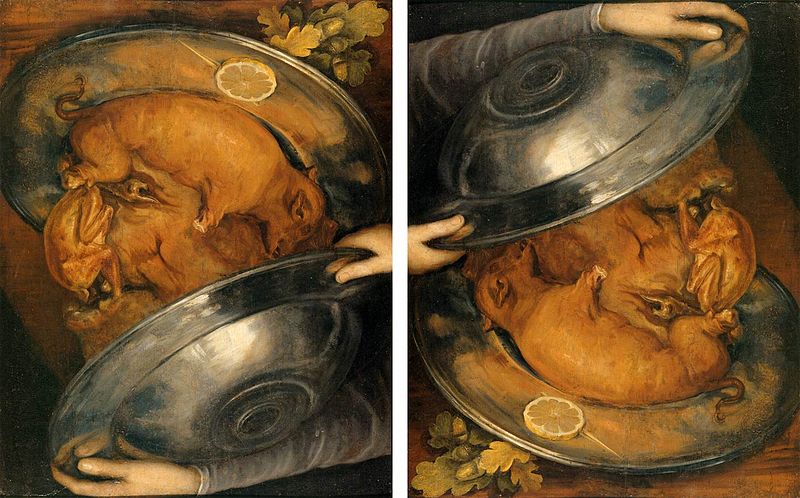
The Cook, a reversible portrait by Italian painter Giuseppe Arcimboldo, circa 1570.
Arcimboldo made a whole series of such paintings.

The Cook, a reversible portrait by Italian painter Giuseppe Arcimboldo, circa 1570.
Arcimboldo made a whole series of such paintings.

Draw a triangle, pick a point on one side, and draw a path as shown, with each segment parallel to a side of the triangle.
The path with always be closed — you’ll always return to your starting point.
Discovered by German mathematician Gerhard Thomsen.
The Guinness record for the most fraudulent election ever reported belongs to the Liberian general election of 1927, in which President Charles D.B. King was re-elected over challenger Thomas J. Faulkner:
| Candidate | Votes | % |
| Charles D.B. King | 243,000 | 96.43 |
| Thomas J. Faulkner | 9,000 | 3.57 |
| Total | 252,000 | 100.00 |
As there were fewer than 15,000 registered voters, this represents a turnout of 1,680 percent — robust indeed.
I just ran across this anecdote by Jason Rosenhouse in Notices of the American Mathematical Society. In a middle-school algebra class Rosenhouse’s brother was given this problem:
There are some horses and chickens in a barn, fifty animals in all. Horses have four legs while chickens have two. If there are 130 legs in the barn, then how many horses and how many chickens are there?
The normal solution is straightforward, but Rosenhouse’s brother found an alternative that’s even easier: “You just tell the horses to stand on their hind legs. Now there are fifty animals each with two legs on the ground, accounting for one hundred legs. That means there are thirty legs in the air. Since every horse has two legs in the air, we find that there are fifteen horses, and therefore thirty-five chickens.”
(Jason Rosenhouse, “Book Review: Bicycle or Unicycle?: A Collection of Intriguing Mathematical Puzzles,” Notices of the American Mathematical Society, 67:9 [October 2020], 1382-1385.)
A puzzle by H.A. Thurston, from the April 1947 issue of Eureka, the journal of recreational mathematics published at Cambridge University:

Grab point C above and drag it to a new location. Surprisingly, M, the midpoint of BaAb, doesn’t move.
This works for any triangle — draw squares on two of its sides, note their common vertex, and draw a line that connects the vertices of the respective squares that lie opposite that point. Now changing the location of the common vertex does not change the location of the midpoint of the line.
It was discovered by Dutch mathematician Oene Bottema.

The keyhole of the Priory of the Knights of Malta in Rome presents a perfectly framed view of Saint Peter’s Basilica.
It’s not clear whether this is a happy accident or a deliberate design. The property lies in the piazza Cavalieri di Malta, which was designed in 1765 by the supremely imaginative Giovanni Battista Piranesi — who imagined the Aventine Hill as a sacred ship that would sail to the heavens.
“Man is certainly crazy. He could not make a mite, and he makes gods by the dozen.” — Montaigne

In 1917, two young cousins carried a camera into an English dell and returned with a photo of fairies. When Arthur Conan Doyle took up the story it became a worldwide sensation. In this week’s episode of the Futility Closet podcast we’ll tell the story of the Cottingley Fairies, a curiosity that would remain unexplained for most of the 20th century.
We’ll also remember a ferocious fire and puzzle over a troublesome gnome.

At the 1936 Olympics, Japanese pole vaulters Sueo Oe and Shuhei Nishida tied for second place, and the Japanese team were told to decide who should claim second place and who third.
After a long discussion, the team chose to favor Nishida, who had cleared 4.25 meters at his first attempt.
When they returned to Japan, Nishida and Oe had a jeweler cut each medal in half and then join the disparate halves, so that each man had a new medal, half silver and half bronze.